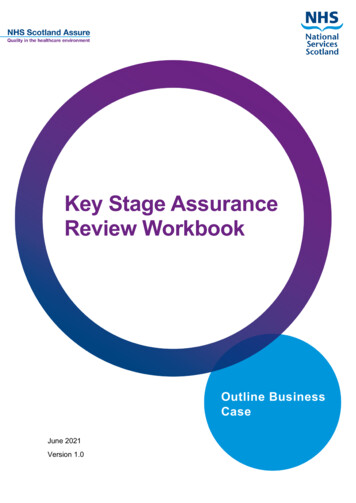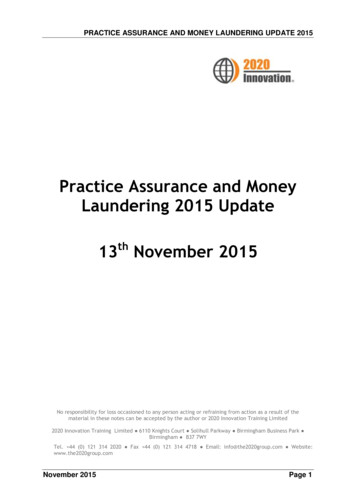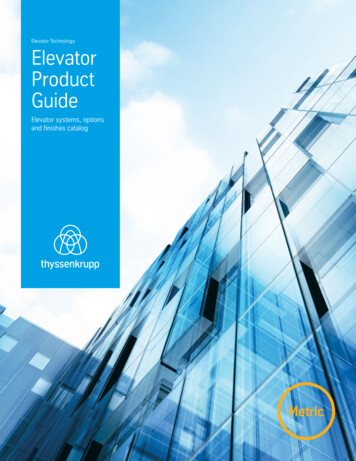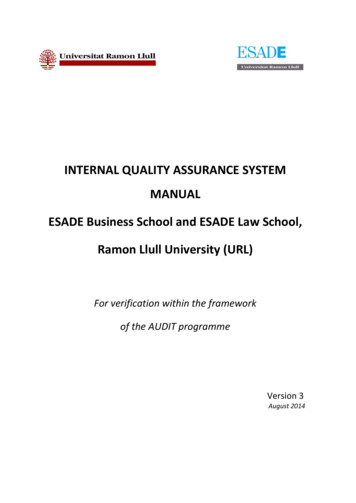
Transcription
Key Stage AssuranceReview WorkbookOutline BusinessCaseJune 2021Version 1.0
ContentsContents . 21. About this workbook . 3Figure 1: Construction Procurement Journey . 3Using this workbook . 42. Key Stage Assurance Review . 5Introduction to NHS Scotland Assure – Assurance Service . 5The KSAR Process . 5Value of the KSAR Process . 5The KSAR Process relationship with NHS Scotland Design AssessmentProcess (NDAP) . 7Sustainability . 8Outline Business Case (OBC) KSAR . 83. Assessment of Delivery Approach . 11Project Governance and General Arrangements . 11Water and Internal Plumbing / Drainage Systems . 16Ventilation . 18Electrical . 21Medical Gases . 23Fire. 26IPC Built Environment . 294. Appendix .Error! Bookmark not defined.KSAR Master Glossary .Error! Bookmark not defined.5. Bibliography .Error! Bookmark not defined.KSAR Workbook Outline Business CaseVersion: 1.0 (June 2021)Page 2 of 31
1. About this workbookThis workbook supports the Outline Business Case Key Stage Assurance Review(KSAR), delivered through the NHS Scotland Assure - Assurance Service.Further information about the NHS Scotland Assure - Assurance Service and KSARprocess is provided in section 2.Figure 1. shows how the Outline Business Case stage in the procurement andconstruction journey commences following Initial Assessment. The timing andfrequency of KSARs during this stage will vary dependent upon the facility. Specificworkbooks have been developed for the other stages within this journey.Figure 1: Construction Procurement JourneyKSARs are of a process ensuring facilities and the teams using them are able todeliver the standards required to provide the best and safest outcomes for patients,staff and visitors in the built environment.KSARs deliver an independent peer review. NSS staff outside the project use theirexperience and expertise to examine the progress and likelihood of successfuldelivery, with a particular emphasis on the safety of the patients, staff and visitorsusing the facility.It is vital to receive feedback on the following elements of health facilities - InfectionPrevention and Control (IPC), water, ventilation, electrical, plumbing, medical gasesKSAR Workbook Outline Business CaseVersion: 1.0 (June 2021)Page 3 of 31
installations and fire. This ensures they are designed, installed and functioning frominitial commissioning of a new facility and throughout its lifetime. Health Boards arerequired to have appropriate governance in place at all stages of the constructionprocurement journey.The KSAR workbook provides a transparent, structured framework for all clinicalspecialisms, facilities and operational management professionals to assess andmanage a health care build or refurbishment. Allowing facilities to align with currentstandards as the assurance reviews are taking place, as well as aligning changes forpatient cohort.Using this workbookThe review at Outline Business Case stage investigates the approach taken by theHealth Board in the development of the design, and how the appropriate level ofknowledge and awareness of patient and user needs will influence the developmentof the design.The purpose of the KSAR at Outline Business Case stage is to confirm there is agood and comprehensive understanding of the category of patient who will use theproposed facility and that the project team consider how appropriate quality andsafety standards will influence the design. It looks to provide assurance that theproject can proceed to the Full Business Case.This workbook is predominantly intended to be used by NHS Scotland Assure KSARreview teams, Health Boards are encouraged to use its content to support their ownprojects. It provides guidance on the review structure and areas of investigation to beaddressed by the review team and should be regarded as indicative and notprescriptive.The review team will consider whether any emerging findings require additionaltopics to be addressed. If so, evidence relating to these areas, regarding the safetyof the patients, staff and visitors should be provided.KSAR Workbook Outline Business CaseVersion: 1.0 (June 2021)Page 4 of 31
2. Key Stage Assurance ReviewIntroduction to NHS Scotland Assure – Assurance ServiceGood management effective control of projects is an essential element to thesuccessful delivery and maintenance of healthcare facilities across NHS Scotlandestates.The initial delivery of the NHS Scotland Assure - Assurance Service will focus uponnew builds and major refurbishments in the acute estate, submitted to the ScottishGovernment Capital Investment Group (CIG). In addition, a number of projectsidentified as being complex, primarily due to the needs of patients utilising thefacilities, will be reviewed by this service. Whilst not an exhaustive list, these projectswill cover oncology, maternity, theatre and critical care units, no matter of theirfinancial value.The NHS Scotland Assure - Assurance Service will deliver KSARs, designed toprovide independent assurance to Scottish Government Health and Social CareDirectorates (SGHSCD’s).It will assess if Health Boards Project Management teams (inclusive of clinicians,appointed construction consultants, and contractors) are briefed and following bestpractice procedures in the provision of facilities. We will review if projects arecompliant in all aspects of safety, if specific engineering systems are designed,installed and commissioned, and for ongoing safety maintenance including IPC.The KSAR process is applicable regardless of procurement route chosen.The KSAR ProcessThe KSAR process examines projects at key points in their lifecycle. It does notremove any legal or contractual obligations from the NHS Health Board, theirdesigners or contractors. It provides assurance to progress successfully to the nextreview point and the process will be mandated for projects requiring CIG approval.KSARs focus on the assessment of the delivery approach, and will work with theHealth Board’s project team to ensure there is comprehensive understanding of thepatient cohorts utilising the facility. KSARs also ensure relevant guidance is fullyimplemented and any technical derogations have been fully reasoned, transparentlydiscussed, the implications understood, recorded and signed off by the Health Boardand their advisors.With a focus on construction elements where previous reviews have demonstratedpotential patient safety concerns, KSARs will concentrate on water; ventilation,electrical, plumbing, medical gases installations, fire, and associated IPC guidance.If further issues are raised with the review team, they will fully incorporate thoseissues into the reporting process.Value of the KSAR ProcessKey Stage Assurance Reviews (KSARs) deliver an independent peer review. NSSstaff outside the Health Board’s project use their experience and expertise toexamine the progress and likelihood of successful delivery, with a particularemphasis on the safety of the patients, staff and visitors using the facility. KSARsprovide an external perspective and provide a challenge to the robustness of theHealth Board’s brief, plans and processes.KSAR Workbook Outline Business CaseVersion: 1.0 (June 2021)Page 5 of 31
This includes work delivered by construction consultants, employed either directly orthrough construction contractors, and the work being delivered by the primarycontractor, their sub-contractors and specialist suppliers.The KSAR provides an independent report and action plan, which is shared with theHealth Board to ensure: Appropriate skills and experience are deployed on the project by the HealthBoard, consultants, primary contractor and all sub-contractors. The clinicians and wider stakeholders covered by the project fully understandthe project status, aims and the issues involved. Appropriate management structures put in place to ensure appropriate infectionprevention and control measures are designed into the project to reduce therisk of transmission of infectious agent. There is assurance the project can progress to the next stage of developmentor implementation with particular emphasis on the safety of the patients, staffand visitors utilising the facility.Provision of advice and guidance to programme and project teams by fellowPractitioners.The KSAR report and the Health Board’s response and action plan is submitted toCIG along with a recommendation from the NHS Scotland Assure - AssuranceService regarding the projects’ progression to the next stage of the constructionprocurement journey. KSAR Workbook Outline Business CaseVersion: 1.0 (June 2021)Page 6 of 31
KSAR as part of the overall assurance frameworkEach NHS Health Board will be fully responsible for the delivery of all projects, andits own internal process and resources for carrying out internal reviews and audits ofits activities. The KSAR is seen as a complementary independent review, and not asa replacement for the responsibilities of the Health Board.NHS Health Boards should have in place an effective framework to provide asuitable level of assurance for their programmes and projects. Health Boards areencouraged and expected to ensure adequate and timely coordination and sharingof information, including plans, between the various internal reviews and functions.The KSAR process is not a substitute for a rigorous governance framework in theBoard to manage key processes including business planning, investment appraisal,business case management, risk management and service and contractmanagement.The KSAR Process relationship with NHS Scotland DesignAssessment Process (NDAP)The Scottish Government’s ambition for NHS Scotland’s estate and the need forwell-designed healthcare environments is articulated in the Policy on Design Qualityfor NHS Scotland. Good design in the built environment encompasses a wide rangeof inter-related factors such as, sustainability, engineering, architecture, fire safety,energy, environment, decontamination, space utilisation, landscaping, security,technology, lighting, access for visitors and mobility impaired persons.The NDAP process is overseen by Health Facilities Scotland and Architecture andDesign Scotland and holistically considers all of the above. It sets the principles forthe resolution of potential conflicts of statutory or mandatory compliance to ensurethe specific facility provides; the best balance of the technical requirements, meetsclinical needs and fulfils the conceptual aims of the policy on Design Quality. TheNDAP process begins at the initial agreement stage of a project and provides advicethrough to the Full Business Case. There is no change to either SCIM or NDAPprocesses.The Scottish Government is progressing policy to improve the safety of thehealthcare environment in relation to the built environment risk. The AssuranceService delivered through NHS Scotland Assure is a response to this policy and theKSARs are integral to the compliance work. The aspiration is not to duplicate any ofthe work included in the NDAP process, but to provide assurance regarding thecritical components highlighted throughout this workbook.Integral to the KSARs will be a review of the balance between sustainability issuesand patient safety.The NDAP, working with Health Boards, will set the principles of the design solution,whereas the KSAR will provide a detailed technical review of the specifics of thedesign solution. Where possible the two reviews will be aligned to avoid duplicationof work. For example, in instances where the NDAP has reviewed detail at atechnical level, this will be used by the KSAR team rather than being separatelyrequested and reviewed.KSAR Workbook Outline Business CaseVersion: 1.0 (June 2021)Page 7 of 31
SustainabilityThe review will provide assurance that the proposals for the project provide aneffective balance in terms of patient, staff and visitors safety, whilst meeting requiredsustainability outcomes and complying with the guidance standards.Outline Business Case (OBC) KSARThis review investigates the approach taken by the Health Board in the developmentof the design, to confirm that there is a good and comprehensive understanding ofthe category of patient utilising the proposed facility, and that the project team areaware of how their needs and expectations for appropriate quality and safetystandards will influence the design of the accommodation. It looks to provideassurance that the project can proceed to the Full Business Case.The OBC KSAR will focus on how this understanding of patient needs andexpectations have influenced the following critical components of design, particularlyin relation to Infection Prevention and Control. Water systems Ventilation systems Plumbing and drainage Fire safety Electrical systems Medical gases Any other building or engineering component critical to the safety and welfareof a particular patient cohort (defined by the review team).KSAR Workbook Outline Business CaseVersion: 1.0 (June 2021)Page 8 of 31
At all stages of design development, knowledge of compliance in design andimplementation will need to encompass (not limited to) the following: NHS Scotland policy letters (DLs,CELs,CMOs) Scottish Health Planning Notes (SHPN) Scottish Health Facilities Notes (SHFN) Scottish Health Technical Memoranda (SHTM) Scottish Fire Practice Notes (SFPN) Health Building Notes (HBN) Health Technical Memoranda (HTM) Health Facilities Notes (HFN) UK construction industry bodies best practice or design guidance publicationse.g. HSE, CIBSE, BRE, IHEEM, IET, BRE, BSRIA, sustainability, dementiaand equality. Incident Reporting and Investigation Centre (IRIC) Alerts Relevant British Standards Other statutory requirements: Planning permission; Building Regulationscompliance; Equality Act compliance; Health and Safety Executive (HSE)compliance; Construction (Design and Management) Regulations compliance;Fire Scotland Act. Other mandatory NHS Scotland use of: Activity Data Base (ADB); Achieving Excellence Design Evaluation Tool; BREEAM Healthcare or equivalent (BRE environmental & sustainabilitytools); Scottish Government BIM Policy (SPPN 1/2017; implementation ofbuilding information modelling within construction projects: March 2017); The implementation of NHS Scotland Soft Landings (SL) guidance Confirm there are plans in place for risk management, issue management andthese plans are being shared with suppliers and delivery partners. Evaluation of actions taken to implement recommendations made in earlierassessment of deliverability. Confirm there are plans in place to ensure the requirements of the NHSScotland National Infection Prevention and Control Manual for Scotland arebeing incorporated which will allow the staff allocated to the role to deliver theservices to the patients.KSAR Workbook Outline Business CaseVersion: 1.0 (June 2021)Page 9 of 31
The review teams consist of experienced operational estates professionals andexperienced Infection Control clinicians. The team will work with the Health Board’sProject Team, inclusive of their clinicians and their appointed facility managementconsultants and contractor. Each review will result in a report being prepared for theProgramme Director at the Board and a copy of the report will also be provided toScottish Government Capital Investment GroupAn appendix is provided which indicates the typical question set for OBC which thereview Team will use as the basis of evidence finding for the KSAR. The review teamwill amend this as necessary depending on the project and areas of particularinterest. The Health Board, their designers and contractors should be aware that thisis the information which will be expected and the design should effectively becompleted at OBC at the time of the KSAR to ensure the accuracy of the report.KSAR Workbook Outline Business CaseVersion: 1.0 (June 2021)Page 10 of 31
3. Assessment of Delivery ApproachThe review at Outline Business Case stage will need to demonstrate an awarenessand knowledge of how the above will be used to influence the initial design.Project Governance and General ArrangementsNo.Areas to probeEvidence expected1.1Evaluation of changes detailedfrom previous KSAR. Assessment of any substantivechanges in highlighted areas fromprevious review stage and all actionshave been implemented.1.2Verification that CIGrecommendations have beenimplemented with respect toprescribed in scope areas. Review of the implementation of allCIG recommendations. Evaluation ofany deviation from previoussubmissions or reviews.1.3Has cross-referencing with NDAPand AEDET recommendationsbeen implemented? An assessment if there is fullcompliance with the applicablerecommendations and actions fromthe preceding step.1.4Does the Health Board continueto demonstrate service / clinicalinput into design decisions basedon a current and comprehensiveknowledge of patient cohorts? Recorded and updated input takenfrom service lead(s) / clinician(s)about relevant patient cohortcharacteristics and their typical needsin terms of the accommodation'senvironment, safety and infectioncontrol standards. Demonstrable expertise of servicelead(s) / clinician(s) in providing thisadvice. Updated and current list available ofall stakeholders, service users andpatient cohorts impacted by thisproject, plus the identification of anyhigh risk groups and their specialistneeds. Updated and recorded engagementon these designs issues having takenplace between the project team andservice lead(s) / clinician(s), infectioncontrol team, and other keystakeholders (e.g. Estates, Medical1.5Project team demonstrates aunified and recordedunderstanding of needs of mainusers and patient cohorts of theproposed accommodation andhow this will influence the designof critical building, engineeringand infection prevention andcontrol quality and safetystandards.KSAR Workbook Outline Business CaseVersion: 1.0 (June 2021)Page 11 of 31
No.Areas to probeEvidence expectedPhysics, IPC, the AEDET, NDAP orother design briefing workshops).1.61.7Planned approach towardsdetermining the necessarystandards for thisaccommodation.How does the Health Boarddemonstrate that there is aneffective infection prevention andcontrol management structure inplace and how does it relate tothe development of the project?How does the Board demonstrateleadership and commitment toinfection prevention and control toensure a culture of continuousquality improvement throughoutthe organisation, and that there isan effective IPC structure in placeand how does it relate to thedesign development?KSAR Workbook Outline Business CaseVersion: 1.0 (June 2021) Details available of how service users/ patient cohort needs and theirexpected use of the accommodationare influencing the design brief;including critical building, engineeringand infection prevention and controlquality and safety standards. Updated and current list of therelevant NHS and non-NHS guidancethat is being used and adopted (seeprevious section of workbook OBCKSAR (Page 9) for examples ofappropriate guidance). Updated and current list of allproposed derogations from NHSguidance with a detailed technicalnarrative on each derogation and / orlist of known gaps in guidance thatwill need to be resolved in order tomeet the needs of the patient / usercohort. Knowledge of the role of infectionprevention and control andmicrobiologist advisors to be usedthroughout the design stages, anddetails of the resource plan in placeto ensure this advice will be available. Evidence IPC and clinical teams havebeen integrated into all decisionsregarding any derogations throughthe design process and are satisfiedthis will not impact on patient safetysuch as, specific sign off, supportingmeeting minutes, risk assessments,risk registers relating to IPC withevidence of escalation through theagreed NHS board governanceprocess.Page 12 of 31
No.Areas to probe1.8Integration with Authority Policiesand Operation.Evidence expected The Health Board can demonstratethe current version of the NationalInfection Prevention and ControlManual has been adopted by theorganisation and all staff are aware ofhow and where to access this (askstaff). IPC are fully embedded in the projectteam and the OBC programme takingcognisance of any actual or perceivedrisks identified provided. Assessment of the Health Boardsapproach to all IPC related matters inrelation to the development of thedesign, HAISCRIBE etc. IPCT annual programme of work.1.10 The Health Boards Monitoringand Records Evidence that the Health Boardintegrating this project with wider IPCrequirements within the context of theOBC. For example, evidence that theproposals for equipping incorporateIPC requirements?1.11 Planned approach for managingthe design process to ensuresuccessful compliance withagreed and approved standards. The project governancearrangements and resource plan inplace to ensure that the necessarydecision making authority andtechnical expertise is available to takeresponsibility for and deliver theproject as planned and agreed. Details of how gaps in expertise arebeing filled. Details of how compliance with theappropriate guidance, design briefand other standards are beingagreed, signed off, monitored,reported against and if necessaryescalated / adjudicated throughoutthe design, construction andcommissioning stages. Details of how all stakeholders'interests are being agreed, signed off,monitored, reported against and ifnecessary escalated / adjudicatedHow does the Health Boarddemonstrate implementation ofevidence based infectionprevention and control measures?1.9The Health Boards InfectionControl StrategyKSAR Workbook Outline Business CaseVersion: 1.0 (June 2021)Page 13 of 31
No.Areas to probeEvidence expectedthroughout the design, constructionand commissioning stages.1.12 The Health Boards approach onthe procurement journey, withevidence of the plans on how theHealth Board will provideassurance, particularly emphasison the critical system identifiedearlier. Evidence on how Infection Preventionand Control are involved with theconceptual procurement approach tothe design stage and future plans forproject. Plans to identify any gaps in theprocurement approach that mayrequire to be addressed. Evidence on how the InfectionControl procedures and managementwill fit with the conceptualprocurement approach and initialthinking on how it will be managed. Evidence of a detailed procurementstrategy report. Evidence that the Health Boardsselected procurement route has gonethrough the Health Board’sGovernance channels. Evidence that the Health Boardintegrating this project with wider IPCrequirements within the context of theOBC. For example, evidence that theproposals for equipping incorporateIPC requirements? Evidence that the procurement of thelead designer will encompass theseareas in their oversight and sign off ofthe complete design. Evidence that a clear demarcation ofdesign responsibility is beingdeveloped.1.14 Evaluation of the Health Boardscommissioning plan. Evidence that the Health Board hasrecorded plans that arecomprehensive and adequate toaddress the needs of the project andthat they are fully resourced.1.15 Evaluation of the Health Boardsduty holder matrix. Evidence that the Health Board havea fully recorded matrix of the requiredroles and responsibilities and have a1.13 The Health Boards approach onthose areas of design that theprocurement route has providedidentification as possibly beingContractors Designed Portions(CDP’s).KSAR Workbook Outline Business CaseVersion: 1.0 (June 2021)Page 14 of 31
No.Areas to probeEvidence expectedclear governance structure that isfully resourced together with plans inplace for the implementation. KSAR Workbook Outline Business CaseVersion: 1.0 (June 2021)Evidence that Health Boards haveappropriate number of competent,qualified staff to carry out specificduties throughout the life cycle of theproject e.g., IPC, Engineers, Estatesstaff etc. The number of competent,qualified staff will depend on the typeand size of the Build Project.Page 15 of 31
Water and Internal Plumbing / Drainage SystemsNo.Areas to probe2.1Has the Health Boardcompleted competency checkson the water and drainageconsultant designers?2.2How does the Health Boardensure that water services aredesigned in a fashion whichwill retain space for minoradditions and modifications toservices in the future?KSAR Workbook Outline Business CaseVersion: 1.0 (June 2021)Evidence expected Recorded evidence that the designteam are experienced and have acomprehensive knowledge of therelevant design standards. Where anyone does not have a recordof extensive health care experiencewhat recorded plans are to be put inplace by the Consultant Designers? Recorded evidence that input from theHealth Boards Authorising Engineer forWater (AE(W)) has been requested. Evidence that the engineers arepresented their co-ordination drawings(BIM model), with space for futureflexibility identified, to the Board. Evidence that the design consultanthas considered and agreed with theBoard, space for future flexibility in theservice installations. Evidence that the designers havepresented each of the main serviceruns plus plant rooms to the Board'sFM team, to highlight space for futureflexibility. Evidence that the Health Board hasagreed a strategy (percentage) forspare capacity and a documentedallowance to be incorporated into thedesign. Are plant/tank rooms, IPS sections,horizontal distribution runs and risersappropriately sized for the equipmentbeing installed and facilitate safeadequate maintenance.Page 16 of 31
No.Areas to probe2.3How does the Health Boardassure itself that all variations /derogations which may berequired to water systems areinvestigated and agreed by allparties before they areincorporated in the design? Evidence that the each variation /derogation has a detailed technicalanalysis and has been referred to theBoard and agreed with their watermanagement group, clinical, Estates,infection prevention and control andFM teams.2.4Water Management Strategy Assessment of Health Board proposedwater management strategy and howthis relates to the proposedspecification, guidance and projectrequirements What involvement has there been fromthe water management group? Has the Health Board commenced itswater governance planning andrecorded how it will ensure appropriatenumbers of trained staff (AP and CP)and AE(W) will be appointed, is therean established project watermanagement group that ensures thewater management strategy is adheredto for the Board, and is it clear how thisproject will interface with this existinggroup? Evidence that the Health BoardsAE(W) have been involved with andreviewed the design proposals to date.2.5Water GovernanceArrangementsKSAR Workbook Outline Business CaseVersion: 1.0 (June 2021)Evidence expectedPage 17 of 31
VentilationNo.3.13.2Areas to probeHas the Health Boardcompleted competencychecks on the ventilationconsultant designers?How does the HealthBoard ensure thatventilation services aredesigned in a fashionwhich will retain space forminor additions andmodifications to servicesin the future and there isan appropriate plantaccess strategy?KSAR Workbook Outline Business CaseVersion: 1.0 (June 2021)Evidence expected Recorded evidence that the design teamare experienced and have acomprehensive knowledge of the relevantdesign standards. Where anyone does not have a record ofextensive health care experience whatrecorded plans are to be put in place bythe Consultant Designers? Recorded evidence that input from theHealth Boards Authorising Engineer forVentilation (AE(V)) has been requested. Evidence that the engineers are presentedtheir co-ordination drawings (BIM model),with space for future flexibility identified, tothe Health Board. Evidence that the design consultant hasconsidered and agreed with the HealthBoard, space for future flexibility in theservice installations. Evidence that the designers havepresented each of the main service runsplus plant rooms to the Board's FM team,to highlight space for future flexibility. Evidence that the Health Board has agreeda strategy (percentage) for spare capacityand a documented allowance to beincorporated into the design. Are plant/tank rooms, IPS sections,horizont
2. Key Stage Assurance Review Introduction to NHS Scotland Assure - Assurance Service Good management effective control of projects is an essential element to the successful delivery and maintenance of healthcare facilities across NHS Scotland estates.










